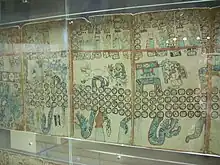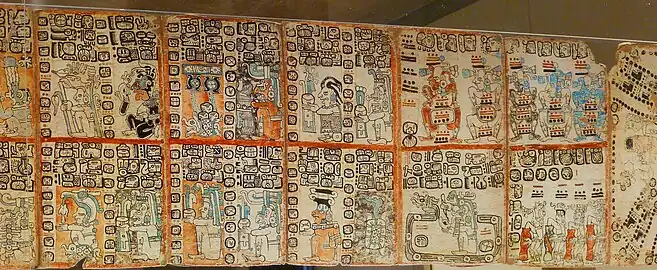
The Madrid Codex (also known as the Tro-Cortesianus Codex or the Troano Codex)[1] is one of three surviving pre-Columbian Maya books dating to the Postclassic period of Mesoamerican chronology (circa 900–1521 AD).[2] The Madrid Codex is held by the Museo de América in Madrid and is considered to be the most important piece in its collection. However, the original is not on display due to its fragility; an accurate reproduction is displayed in its stead.[1] At one point in time the codex was split into two pieces, given the names "Codex Troano" and "Codex Cortesianus". In the 1880s, Leon de Rosny, an ethnologist, realised that the two pieces belonged together, and helped combine them into a single text. This text was subsequently brought to Madrid, and given the name "Madrid Codex", which remains its most common name today.[3]
Physical characteristics
The Codex was made from a long strip of amate paper that was folded up accordion-style. This paper was then coated with a thin layer of fine stucco, which was used as the painting surface.[4] The complete document consists of 56 sheets painted on both sides to produce a total of 112 pages.[4] The Troano is the larger part, consisting of 70 pages comprising pages 22–56 and 78–112. It takes its name from Juan Tro y Ortolano. The remaining 42 pages were originally known as the Cortesianus Codex, and include pages 1–21 and 57–77.[5] Each page measures roughly 23.2 by 12.2 centimetres (9.1 by 4.8 in).[4] on the 56th page there is a patch of paper that does not match the rest of the paper. The patch is believed to be of European paper, however further research has not been conducted as it could be harmful to the codex.[6]
Content

The Madrid Codex is the longest of the surviving Maya codices.[4] Its content mainly consists of almanacs and horoscopes used to help Maya priests in the performance of their ceremonies and divinatory rituals. The codex also contains astronomical tables, although fewer than those in the other three surviving Maya codices.[7] Some of the content is likely to have been copied from older Maya books.[8] Included in the codex is a description of the New Year ceremony.[9]
The codex is stylistically uniform, leading Coe and Kerr to suggest that it was the work of a single scribe. Closer analysis of glyphic elements suggests that a number of scribes were involved in its production, perhaps as many as eight or nine, who produced consecutive sections of the manuscript.[10] The religious content of the codex makes it likely that the scribes themselves were members of the priesthood. The codex probably was passed down from priest to priest and each priest who received the book added a section in his own hand.[9]
The images in the Madrid Codex depict rituals such as human sacrifice and invoking rainfall, as well as everyday activities such as beekeeping, hunting, warfare, and weaving.[4] Other images show deities smoking sikar (see tables 25, 26, and 34 of the Codex), similar to modern cigars made of tobacco leaves.[11]
Origin
Some scholars, such as Michael Coe and Justin Kerr,[12] have suggested that the Madrid Codex dates to after the Spanish conquest, but the evidence overwhelmingly favors a pre-conquest date for the document. The codex likely was produced in Yucatán.[7] The language used in the document is Yucatecan, a group of Mayan languages that includes Yucatec, Itza, Lacandon, and Mopan; these languages are distributed across the Yucatán Peninsula, including Chiapas, Belize, and the Guatemalan department of Petén.[4] J. Eric Thompson was of the opinion that the Madrid Codex came from western Yucatán and dated to between 1250 and 1450 AD. Scholars also suggest that the codex may have originated from the Petén region of Guatemala.[13] Other scholars have expressed a differing opinion, noting that the codex is similar in style to murals found at Chichen Itza, Mayapan, and sites on the east coast such as Santa Rita, Tancah, and Tulum.[8] Two paper fragments incorporated into the front and last pages of the codex contain Spanish writing, which led Thompson to suggest that a Spanish priest acquired the document at Tayasal in Petén.[14]
Discovery

The codex was discovered in Spain in the 1860s, and was divided into two parts of differing sizes that were found in different locations.[7] The codex receives its alternate name of the Tro-Cortesianus Codex after the two parts that were separately discovered.[5] Early Mayanist scholar Léon de Rosny realised that both fragments were part of the same book.[15] The larger fragment, the Troano Codex, was published with an erroneous translation in 1869–1870 by French scholar Charles Étienne Brasseur de Bourbourg,[16] who found it in the possession of Juan de Tro y Ortolano in Madrid in 1866 and first identified it as a Maya book.[17] Ownership of the Troano Codex passed to the Museo Arqueológico Nacional ("National Archaeological Museum") in 1888.[4]
Madrid resident Juan de Palacios tried to sell the smaller fragment, the Cortesianus Codex, in 1867.[18] The Museo Arqueológico Nacional acquired the Cortesianus Codex from book-collector José Ignacio Miró in 1872. Miró claimed to have recently purchased the codex in Extremadura.[19] Extremadura is the province from which Francisco de Montejo and many of his conquistadors came,[7] as did Hernán Cortés, the conqueror of Mexico.[20] One of these conquistadors possibly brought the codex to Spain;[7] the director of the Museo Arqueológico Nacional named the Cortesianus Codex after Hernán Cortés, supposing that he himself had brought the codex to Spain.[20]
Gallery
 Page 34: astronomy
Page 34: astronomy

_(14578611557).jpg.webp) Middle divisions of pages 10 and 11 of the Codex Tro-Cortesiano, showing one tonalamatl extending across the two pages
Middle divisions of pages 10 and 11 of the Codex Tro-Cortesiano, showing one tonalamatl extending across the two pages_-_Page_of_Troano_Manuscript_-_Google_Art_Project.jpg.webp) Reproduction of page of Trono Manuscript
Reproduction of page of Trono Manuscript
See also
Notes
- 1 2 García Saíz et al. 2010, p. 54.
- ↑ Sharer and Traxler 2006, p. 126.
- ↑ Paxton, M (2001). The Cosmos of the Yucatec Maya: Cycles and Steps from the Madrid Codex. University of New Mexico Press, Albuquerque.
- 1 2 3 4 5 6 7 Noguez et al. 2009, p. 20.
- 1 2 FAMSI.
- ↑ Bower, Jessica (2016). "The Mayan Written Word: History, Controversy, and Library Connections". The International Journal of the Book. 14 (3): 19–20. Retrieved 20 October 2023.
- 1 2 Ciudad et al. 1999, p. 879.
- ↑ Ciudad et al. 1999, p. 877.
- ↑ "Charles Zidar - Ancient Maya Botanical Research". research.famsi.org. Retrieved 2019-02-24.
- ↑ Miller 1999, p. 187.
- ↑ Vail, Gabrielle; Bricker, Victoria R.; Aveni, Anthony F.; Bricker, Harvey M.; Chuchiack, John F.; Hernandez, Christine L.; Just, Bryan R.; Macri, Martha J.; Paxton, Merideth (2003). "New Perspectives on the Madrid Codex". Current Anthropology. 44 (S5): S105–S112. doi:10.1086/379270. S2CID 160017024 – via University of Chicago Press Journals.
- ↑ Coe 1999, p. 200. Ciudad et al. 1999, p. 880.
- ↑ Sharer and Traxler 2006, pp. 126, 135.
- ↑ Sharer and Traxler 2006, pp. 127, 135. Noguez et al. 2009, p. 20.
- ↑ Sharer and Traxler 2006, p. 135. Vékony 1999. Noguez et al. 2009, p. 20.
- ↑ Sharer and Traxler 2006, p. 127. Noguez et al. 2009, p. 20.
- ↑ Noguez et al. 2009, pp. 20–21.
- 1 2 Noguez et al. 2009, p. 21.
References
- Ciudad Ruiz, Andrés; Alfonso Lacadena (1999). J.P. Laporte and H.L. Escobedo (ed.). "El Códice Tro-Cortesiano de Madrid en el contexto de la tradición escrita Maya" [The Tro-Cortesianus Codex of Madrid in the context of the Maya writing tradition] (PDF). Simposio de Investigaciones Arqueológicas en Guatemala, 1998 (in Spanish). Guatemala City, Guatemala: Museo Nacional de Arqueología y Etnología: 876–888. Archived from the original (PDF) on 2011-09-14. Retrieved 2012-07-23.
- Coe, Michael D. (1999). The Maya. Ancient peoples and places series (6th edition, fully revised and expanded ed.). London and New York: Thames & Hudson. ISBN 0-500-28066-5. OCLC 59432778.
- FAMSI. "Maya Hieroglyphic Writing – The Ancient Maya Codices: The Madrid Codex". FAMSI (Foundation for the Advancement of Mesoamerican Studies). Retrieved 2012-07-24.
- García Sáiz, Concepción; Félix Jiménez; Araceli Sánchez Garrido; Salvador Rovira (2010). Museo de América: Guía Breve [Museum of the Americas: Short Guide] (in Spanish). Madrid, Spain: Ministerio de Cultura. ISBN 978-84-8181-476-7.
- Miller, Mary Ellen (1999). Maya Art and Architecture. London and New York: Thames & Hudson. ISBN 0-500-20327-X. OCLC 41659173.
- Noguez, Xavier; Manuel Hermann Lejarazu; Merideth Paxton; Henrique Vela (August 2009). "Códices Mayas" [Maya codices]. Arqueología Mexicana: Códices prehispánicos y coloniales tempranos – Catálogo (in Spanish). Editorial Raíces. Special Edition (31): 10–23.
- Sharer, Robert J.; Loa P. Traxler (2006). The Ancient Maya (6th, fully revised ed.). Stanford, California: Stanford University Press. ISBN 0-8047-4817-9. OCLC 57577446.
- Vékony, Atilla (1999). "Mayan Codex Facsimiles". University of Arizona. Retrieved 2012-07-24.
Further reading
- Bill, Cassandra R.; Christine L. Hernández; Victoria R. Bricker (2000). "The relationship between early colonial Maya New Year's ceremonies and some almanacs in the Madrid Codex". Ancient Mesoamerica. Cambridge University Press. 11 (1): 149–168. doi:10.1017/s0956536100111034. ISSN 0956-5361. OCLC 365511722. S2CID 162281443. (subscription required)
- Vail, Gabrielle Vail; Victoria R. Bricker; Anthony F. Aveni; Harvey M. Bricker; John F. Chuchiak; Christine L. Hernández; Bryan R. Just; Martha J. Macri; Merideth Paxton (December 2003). "New Perspectives on the Madrid Codex". Current Anthropology. Chicago, Illinois, USA: University of Chicago Press. 44 (supplement) (S5 Special Issue Multiple Methodologies in Anthropological Research): S105–S111. doi:10.1086/379270. JSTOR 10.1086/379270. OCLC 820604805. S2CID 160017024. (subscription required)
- Vail, Gabrielle; Aveni, Anthony (September–October 2008). "El códice madrid, un viejo documento revela nuevos secretos" (PDF). Arqueología Mexicana (in Spanish). Mexico City, Mexico: Editorial Raíces. XVI (93): 74–81. ISSN 0188-8218. OCLC 832413394. Archived from the original (PDF) on 2010-02-06. Retrieved 2013-05-03.
